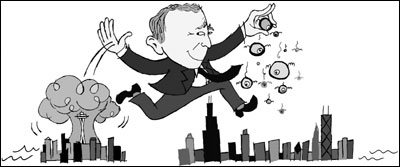FEW WOULD DOUBT the need for disaster preparedness. But last week’s expensive and highly visible terrorism drills in Chicago and Seattle raisedor should raisesome pointed questions about funding priorities and the political uses of what ought to be the least-politicized of government functions.
The exercises, code-named Operation TopOff2, were intended to simulate a bio-terror attack of pneumonic plague (Chicago) and a “dirty bomb” (Seattle). The listed cost of $16 million doesn’t include person-hours, the cost to local jurisdictions, or the disruptions of, for example, traffic, which was even uglier than usual.
The stated goal was to find flaws in America’s preparedness, which is well and good. But as with similar exercises three years ago in Denver and New Hampshire, the cracks found are most likely to be in localnot nationalcoordination. And the threats responded to this year are types that not only have never happened but ignore the more-pedestrian but very real threat demonstrated again last week in Saudi Arabia.
The Saudi Arabia attacks were very much in the Al Qaeda mold. Both were low-tech and, as in the 1998 African embassy bombings and in 9/11, were multiple and simultaneous strikes. Yet both of last week’s TopOff2 scenarios presumed expensive, technologically savvy attackers willing to put all their microbes or nukes into one basket. Rational terrorists would either use a technology that more easily enables multiple attacks (like conventional explosives) or would wait until they have enough microbes or nuclear material for more than one attack of that type.
TOPOFF2 DIDN’T ASSUME either one. The simulated plague attack at the Denver Performing Arts Center three years ago turned up a rapid spread that overwhelmed local hospitals; last week’s Chicago exercise strained its hospitals to capacity. In New Hampshire three years ago, what was found was poor agency coordination.
So far, then, what we know is that if someone ever releases pneumonic plague, we’d better hope it’s in a city with more hospitals than Denver, and we want to avoid the type of emergency-response chaos that comes with bureaucratic confusion. I’m glad we tested that again while almost every relevant federal agency is still being folded into a new Department of Homeland Security.
Limitations like the lack of a realistic scenario or widely applicable benefits are worth noting because the sheer size and cost of the exercises, the largest of their kind in U.S. history, can only be explained when one other “benefit” is factored in: the benefit politicians gain by showing the public, as visibly as possible, that “something” is being done. Otherwise, the visibility and the improbable scenarios are the two elements that separate an elaborate, war game-style exercise like TopOff2 from your run-of-the-mill disaster-preparedness exercise.
SUCH PUBLIC SHOWINESS, along with generous yet haphazard spending, has characterized much of the Bush administration’s post-9/11 federal response to the threat of terror. While the two deadliest attacks in U.S. history used a fertilizer bomb (Oklahoma) and box cutters (9/11), the big money seems to have gone into esoteric scenarios that demand esoteric, costly solutions. For example, my Seattle Weekly colleague, Eric Scigliano, reported last month on a project called BioWatch, which involves installing monitoring systems in major U.S. cities to provide early warning of the release of pathogens like the plague. The only problems are that BioWatch only works if the pathogen is one being tested for; if the release is outdoors (rather than indoors, where it’s most effective); and if the release is either right in front of a monitor or in quantities only possible with a bomb or airplane, both of which we already know how to detect. Meantime, the bidding process will be as quiet and, doubtless, as generous and well-rigged for the politically connected as any Iraq reconstruction contract.
Meanwhile, both Chicago and Seattle have enormous, important downtown areas just yards from where boats could pull up with the kind of explosives Al Qaeda favors, and annual federal spending on scientific research into the spread and treatment of diseases like pneumonic plague is substantially less than the cost of TopOff2 exercises. Are last week’s drills the best use of preparedness money? Despite America’s long record of violence overseas, nobody in this country, including our politicians and disaster planners, has much experience in sorting out the credible risks from the fanciful ones.
Politicians, howeverboth Republican federal officials and the Democratic leaders of Chicago and Seattlehave plenty of experience in creating vacant public spectacle and generous private largesse. Events like Operation TopOff2 encourage us to fear the improbable and to spend a lot of money on itand not to ask if there are more probable threats we should spend money on, instead.







